- General:
- Implementing transaction requires maintaining log information of each update operation executed by transactions
- Transaction log:
-
Transaction log =
an
append only file
consists of entries called
log records
- The information stored in the
transaction log will enable the
database system to:
- Roll back
(i.e., undo) a
transaction,
or
- Redo a
transaction
or
- Both (roll back and undo).
- Roll back
(i.e., undo) a
transaction,
or
-
Transaction log =
an
append only file
consists of entries called
log records
- There are, in general, 2 ways to implement
transaction processing
--- depending on
when the
write/update operation
takes place:
- (Transaction execution use
in-place update/write operation)
and
(Transaction implementation uses
an UNDO log )
- (Transaction execution use deferred update/write operation) and (Transaction implementation uses a REDO log )
- (Transaction execution use
in-place update/write operation)
and
(Transaction implementation uses
an UNDO log )
- We will first discuss the
in-place
update/UNDO log approach.
- In place update (or
immediate update
- In-place write operation = will make the updates immediately to the database
An
When transaction T1 updates the data item X (in place), and later, a transaction T2 reads the data item X , then T2 will read the new value of X
- An
UNDO log
is a log file that contains
information to UNDO the effect
of transactions
- A effect of a transaction
changing values in some records in
the database
To undo the effect of a transaction is to undo the updates made by the transaction
- In order to
undo the updates
made by the transaction, we
save the original (old) value
of every updated data item !!!
- An
UNDO log
contains the following types of
log records
- [start, TID] :
indicates that transaction
TID
has
started
- [write, TID, X, old_value]:
indicates that transaction
TID
has
over-written data item X
whose value was old_value
- [commit, TID] :
indicates that transaction
TID
has
completed successfully
- [abort, TID] :
indicates that transaction
TID
has been
aborted
- [start, TID] :
indicates that transaction
TID
has
started
- Operation:
- When a new transaction begins ,
do:
- Assign a unique transaction ID T to the transaction
- Append [start, T] to the UNDO log
- When transaction T
reads
a data item X:
- Don't need to do anything...
- When transaction T
writes
a data item X:
- Append [write, T, X, old_value] to the UNDO log
- AFTER the log has been written successful , update X (with the new value)
- When transaction T
completes successfully:
- Append [commit, T] to the UNDO log
- When transaction T
is aborted:
- Append [abort, T] to the UNDO log
NOTE:
-
It is
crucial
that:
- You first write the WRITE action in the log and then update the database in-place
It you reverse these steps , then the transaction cannot be guarantee to execute atomically
- When a new transaction begins ,
do:
- Consider a simple transaction
T
that updates a value
x :
T: x := x - 1000 y := y + 1000(E.g., transfer $1000 from back account x to y )
- Initially, the database state is as follows:
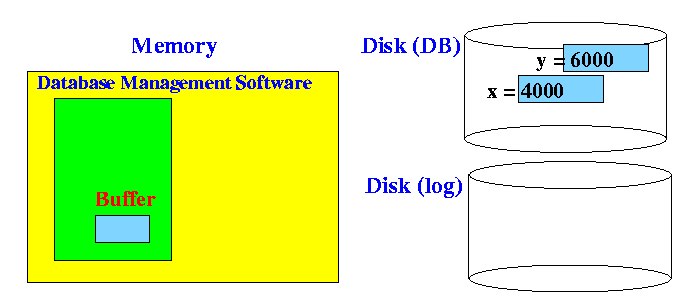
- Transaction processing is as follows:
- When transaction
T starts,
the transaction processing system
writes a
start transaction
to to log file:
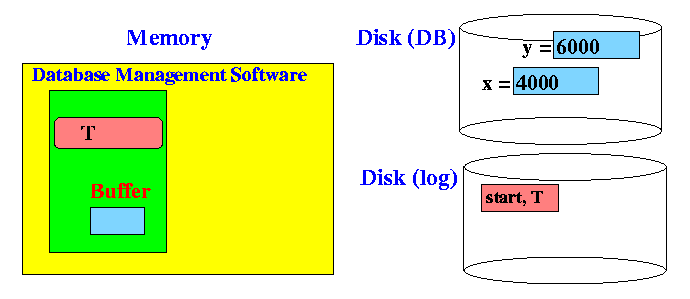
- Transaction
T
must
read
the data item x from disk
into its
memory buffer
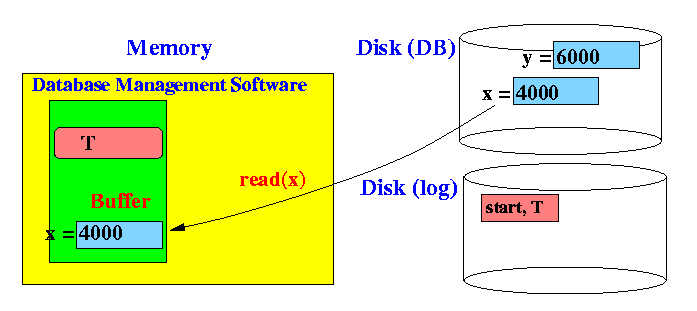
- To
update data on disk ,
the transaction first
update
the data item x
in its
memory buffer
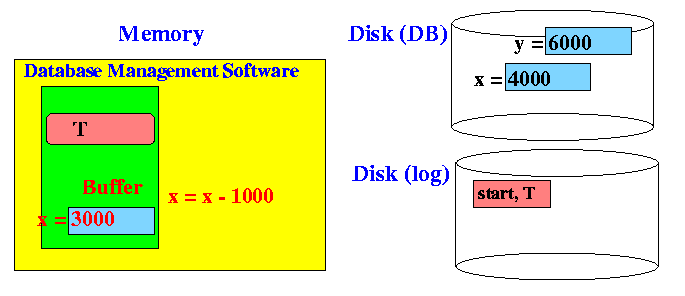
- Transaction
T
writes
the data item x from its buffer
to
disk:

Notice that the old value of x is written to the log before writing the data item x to to database
(We will soon see why the reverse will not work )
- Transaction
T
then
read
y from disk
into its
memory buffer
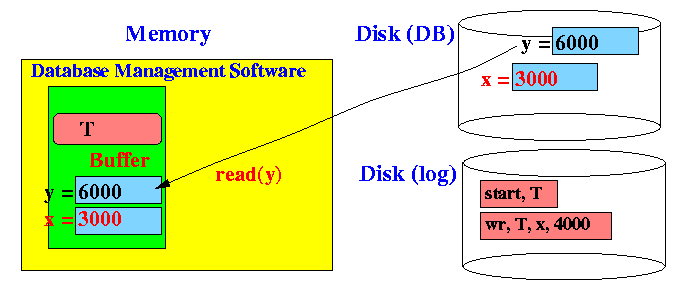
- T first
update
the data item y
in its
memory buffer
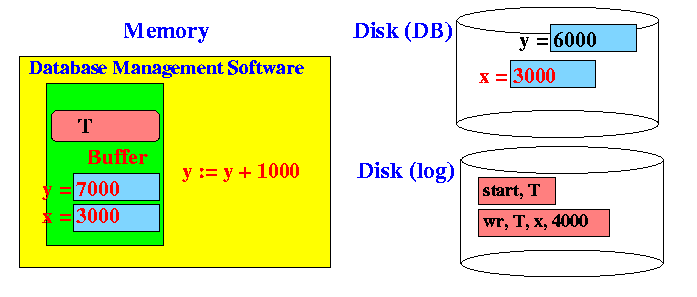
- Transaction
T
writes
the data from its buffer
to
disk:
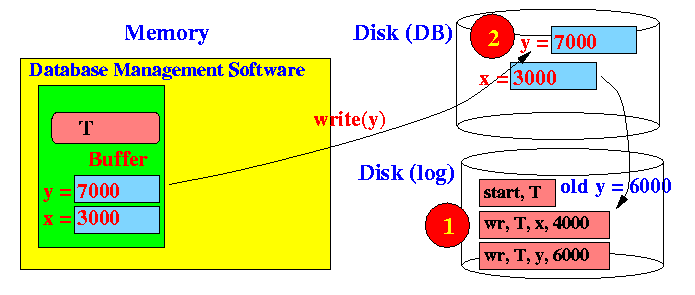
Again: the old value of x must be written to the log before the data item x (to database)
(The reverse will not work )
- Finally,
transaction
T
completes:
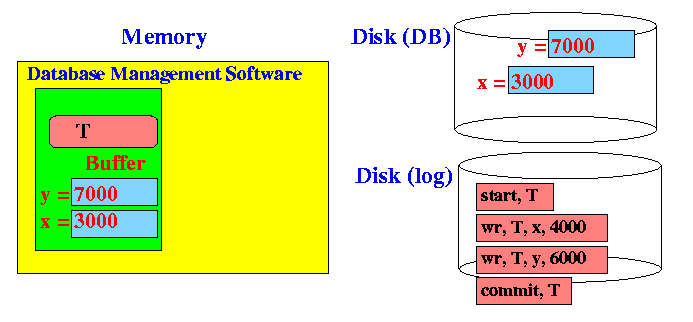
Notice that a commit record written to the log
- When transaction
T starts,
the transaction processing system
writes a
start transaction
to to log file:
- Recall that the
execution
of a transaction
is atomic :
- Either everything is done (i.e., both x and y are updated
- Or else nothing is done (i.e., both x and y are NOT updated
- Question:
What can cause partial execution ? Answer:
- System failure
- Access conflict (later)
- Consider a
system failure occurred at
some step in the above execution:
- System failed before step 1 is complete:

x and y unchanged - no problem
- System failed before step 2 is complete:

x and y unchanged - no problem
- System failed before step 3 is complete:

x and y (in the database) unchanged - no problem
- System failed before step 4 is complete:

- If system fail
before
writing of the log record ,
then x and y
(in the database)
are unchanged - no problem
- If system fail
after
writing of the log record ,
but
before
writing of the database,
then:
- x and y (in the database) are unchanged
- However, the log contains old x = 4000
We are NOT certain whether x was modified... but we need to make sure that x gets back its original value !!!
To make certain that the transaction is atomic , we restore the value of x to its old x = 4000
- If system fail
after
writing of the database,
then:
- x = 3000 and y is unchanged - We has lost $1000 !!!
- Fortunately the log contains old x = 4000
We again use the log record to restore x to its orginal old x = 4000
NOTE:
- Here we see why we
must write the log
before
updating the data in the database
- If the data item x is updated first , and the system fails before the log is written , then we CANNOT restore x to its old value (because we don't have the log record - which could not be written because the system failed before it could write the log)
- If system fail
before
writing of the log record ,
then x and y
(in the database)
are unchanged - no problem
- System failed before step 5 is complete:

x = 3000 and y = 6000 - We has lost $1000 !!! Fortunately the log contains old x = 4000
We use the log record to restore (UNDO) x to its orginal old x = 4000
- System failed before step 6 is complete:

Ditto: x = 3000 and y = 6000 - We has lost $1000 !!! Fortunately the log contains old x = 4000
We use the log record to restore (UNDO) x to its orginal old x = 4000
- System failed before step 7
is complete:

- If system fail
before
writing of the log record
(for y),
then x = 3000
and y = 6000
We can use the log record for x to restore (UNDO) x to its orginal old x = 4000
We don't need to restore y !
- If system fail
after
writing of the log record
(for y),
but
before
writing y,
then:
- x = 3000 and y = 6000 (in the database)
We are NOT certain whether y was modified... but we need to make sure that BOTH x AND y gets back its original value !!!
To make certain that the transaction is atomic , we restore the values of x to its old x = 4000 and y to its old y = 6000
- If system fail
after
writing of the database,
then:
- x = 3000 and y = 7000
Although it is correct, we do NOT have any way of know that y was updated
To make certain that the transaction is atomic , we must mkae this choice:
-
restore
the values of
x
to its old x = 4000
and
y
to its old y = 6000
That's the only safe option.
- If system fail
before
writing of the log record
(for y),
then x = 3000
and y = 6000
- System failed before step 8 is complete:

- System failed
before the COMMIT record
was written
In this case, we don't have any way of knowing that both x and y were updated for certain .
We do have both old values, so:
-
restore
the values of
x
to its old x = 4000
and
y
to its old y = 6000
- System failed
after the COMMIT record
was written
In this case, we DO have the commit record to tell us that both x and y were updated for certain !!!.
So when we see a [commit, T] record, we do NOT undo the transaction T (using the old values)
There are 2 possibilities: - System failed
before the COMMIT record
was written
- System failed before step 1 is complete: